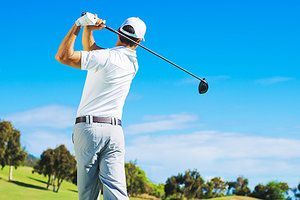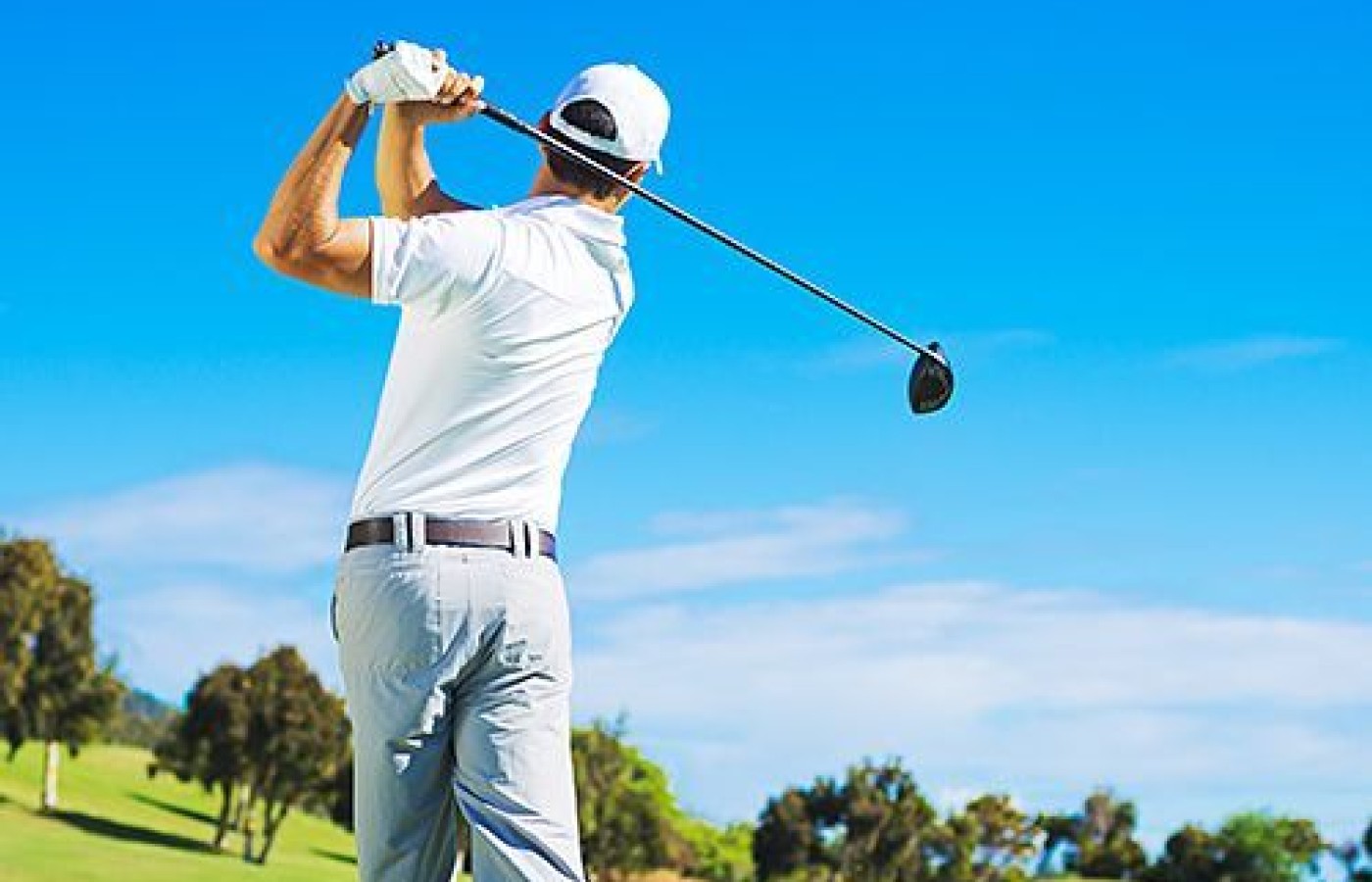Many relevant diagnostic signs are not performed deliberately by the examiner or by the patient at the examiner’s direction. They are observed as the patient reacts to their condition. Fortin’s finger sign, Minor’s sign, and Vanzetti’s sign are three examples of this principle.
Keeping the Swing Sweet
With high levels of earnings at stake each week for the PGA golfer, it is critical that down time be kept to a minimum. The objective from the clinician's perspective is always to secure an accurate assessment of the injuries presented and utilize all conservative means at our disposal to efficiently resolve the condition. It is imperative that each chiropractic physician be capable of offering golfers the most up-to-date care. A comprehensive approach to assessment, treatment, rehabilitation and supportive care is necessary to expedite healing time. Let's examine injury patterns in golfers and review an injury case from evaluation through diagnosis and treatment.
Patterns of Overuse
Although PGA golfers can and do suffer traumatic injuries as a result of abrupt swing changes caused by tree roots and heavy rough, most injuries are nontraumatic and overuse in nature. In golf terms, overuse encompasses physical demands such as the following:
- The average amateur golfer swings a golf club 80-100 mph.
- On the driving range, the average golfer will hit 75-110 balls per 1/2 hour.
- The average golfer practices 1.5-2 hours per day, on average.
- PGA golfers will take 350-450 swings per day playing and practicing.
- On average, a PGA golfer swings a club 100-130 mph.
The repetitive nature of the golf swing and the overuse profile of injury can be confusing for the clinician to interpret. The etiology of injury is not usually due to an abrupt traumatic occurrence that typically occurs in contact sports such as football, hockey and soccer. Injuries in golf frequently present as: 1) acute symptoms that are the result of chronic imbalances in movement patterns involving mobility, stability, or muscle activation; or 2) symptom production found in areas that are not the primary site of dysfunction.

Therefore, when a golfer presents with an injury, the doctor should always focus on the site of pain, but also must consider the golfer's status globally. Examine the area of involvement and then assess entire body function musculoskeletally as soon as is permissible based on pain presentation.
The lower back is the most common site of pain presentation, with PGA golfers presenting for low-back evaluation in 70 percent of total visits. However, approximately 30 percent of these lower back presentations are the result of dysfunction elsewhere in the body.1 It is not unusual to have a PGA golfer present with lower back pain, only to find their shoulders are the primary cause. Performing a thorough examination and movement assessment will allow you to minimize the chance of missing this relationship.
Case in Point
A right-handed PGA golfer presents with left lower back pain. Pain is periodically sharp with twisting on his backswing; otherwise, it is dull, achy and localized to the left lower back. Pain began gradually over the past month with no specific cause.
Examination findings: Lumbar F (60), E (25), RLF (30), LLF (20), RR (30), LR (30) left LBP with LLF, LR. Kemp's, Yeoman's and Milgram's tests were positive for left LBP. SLR and Bechterew's tests were negative.
Deep tendon reflexes and sensory examination in the lower extremities were equal and symmetrical. Manual muscle testing revealed the left hip extensors +4/+5 relative to the right.
Selective Functional Movement Assessment (FN: functional, no pain; DN: dysfunctional, no pain; DP: dysfunctional, painful):
- Pelvic tilt test: DN (with flexion)
- Pelvic rotation test: FN
- Shoulder rotation test: DN (when left shoulder rotates forward, left hip goes with it)
- One-legged rotation: FN
- Overhead squat test: DP (left shoulder)
- Seated thoracic rotation: FN
- Half-kneeling rotation: FN
- Lat test: DN (left)
- Breakout on shoulder: Left shoulder: abduction/ external rotation DP; adduction / internal rotation DN. Right shoulder: abduction / external rotation FN; adduction / internal rotation FN. Left shoulder: Positive impingement tests (Neer's, Hawkins'); Jerk test; Rockwood test (90, 120 degrees).
Mechanism of Injury
The anatomical design of the lumbar facet joints renders it capable of 12-15 degrees of rotation in the upright posture. Rotational demands exceeding this will increase the probability of breakdown in other elements in the lower back.
From address to the apex of the backswing, the left shoulder must go through a series of movements. At address, the left shoulder is adducted and internally rotated, and accompanied by left scapular protraction. This muscular activity increases throughout the backswing, since the golfer is working to keep his torso stable and let his shoulders rotate around a neutral spine.
Any aberrant mobility, stability or activation patterns in the left shoulder will cause one of two basic occurrences: either the left shoulder will develop symptoms due to its inability to handle this demand; and/or its lack of function will be accommodated for and made up elsewhere in the body.
In this golfer's experience, his left lower back attempted to assist the dysfunction in his left shoulder. The left shoulder could not do its job completely, so the left lower back provided a component of right rotation it was not designed to do. The result was that the left erector spinae and quadratus lumborum were strained, and the lower lumbar facet joints were stressed.
Swinging a club an average of 300-plus times on a regular basis and demanding maximal lumbar spine rotation often exceeding its normal capability, this became a recipe for disaster for his lower back. It would be like running your car at 100 mph all the time – the chances of breakdown are very high.
Problem-Solving: Getting to the Source of the Dysfunction
Many right-handed golfers who experience left shoulder pain will find their problem lies in the rotator cuff. From address to the apex of the backswing, the left humeral head rotates medially and compresses into the medially aspect of the glenoid fossa. It is important, relative to golf technique, that during this interval of the golf swing the torso be held stationary and the shoulders rotate about the spine. This demand will narrow the subacromial space and increase the probability of rotator-cuff impingement.
Impingement can occur with the supraspinatus being pinched between the acromium and the head of the humerus or against the coracoacromial ligament. Frequently, tenderness will be at the supraspinatus tendon or over the coracoacromial ligament.
Impingement of this nature often occurs gradually, as does the tendon inflammation. As tendon irritation progresses and fibrotic changes ensue, the tendon thickens and further diminishes the subacromial space it has to move in.
Once the PGA golfer reached this stage of tendonosis, he started to alter how he got to the apex of his backswing. His rotator cuff and interscapular musculature began to tighten and stiffen, as they were guarding the painful shoulder movement. His supraspinatus, infraspinatus, teres minor, teres major, subscapularis, as well as the rhomboids and levator scapula, tightened to protect against excessive stress demands. Major muscle groups such as the pectoralis major and latissimus dorsi also tightened near their attachments to the humerus.
The ability of the left shoulder to rotate around the spine is decreased in avoidance of the left shoulder pain that occurs with that motion. The most immediate mobile area to help out is the thoracic spine. Mobility in this area can be compromised by trapezius and rhomboid tightness due to the left shoulder pathology.
Physical rotational demand would then fall on the lumbar spine due to the strong influence of the latissimus dorsi's attachment to the lower thoracic and lumbar spine, as well as the iliac crest. To eccentrically contract and accommodate right torso rotational stress, the lower and mid latissimus dorsi are put under a great deal of stress to assist in the rotational demand. Such a powerful muscle will pull at its attachments to assist and stabilize right lumbar rotation that, in this case, was more than the lumbar spine could handle.
Deep erector spinae, multifidi, and facet joint capsules were under strain to allow the desired movement. Lower back pain could then be experienced due to inflammation of any one of these structures.
Treatment Objectives
- Improve mobility of the lumbar region, scapulothoracic-humeral area, left latissimus dorsi and pectoralis major muscles utilizing advanced soft-tissue procedures.
- Improve mobility of the lower lumbar facet joints and mid/upper thoracic facet joints with manual spinal manipulation.
- Improve stability of the left rotator cuff and scapulothoracic areas.
- Improve muscle activation patterns of the left rhomboids, posterior deltoid, teres minor / major, infraspinatus, trapezius and levator scapula.
Soft-tissue rehabilitation began with establishing mobility in all involved tissues and joints. Stabilizing progressions began with isometric / activation patterns (short duration to longer duration as progress was noticed). Elastic tubing was utilized beginning with slow, deliberate repetitions and advancing to faster, quick movements.
As the golfer progressed, movement patterns were performed in the upright posture with a two-legged stance, then one-legged, and finished on a foam roller. Overall, the golfer was treated three visits per week and symptoms resolved in four weeks. Supportive care and ongoing exercise therapy were advised and agreed upon by the golfer.
Working Diagnosis
- Left lumbosacral strain/sprain with facet syndrome (secondary to left rotator-cuff impingement)
- Left rotator-cuff impingement syndrome (primary)
The diagnosis sounds a bit different from the conventional thinking mandated by insurance carriers. However, from a global assessment of body movement, this is how the body physically functions. Every movement is based on a sequence of muscle interactions. Sequencing depends on the functional capability of muscles, ligaments, connective tissue and joint structures.
With the high-level demands of professional sports, this understanding is imperative for effective treatment and outcome resolution. Tunnel vision is often due to our daily in-office programming and influences of insurance reimbursement. In the sports medicine arena, where demand for expedient injury resolution is magnified, tunnel vision is detrimental. Your clinical presence in sports can be short lived if your approach is not body comprehensive.
A comprehensive approach to treatment will not only improve your outcome measures; it will also be stimulating to your mental component professionally. When there is so much to evaluate and so many treatment approaches to take, you will find yourself anxious for further knowledge. Even if your treatment protocol is not comprehensive, being aware of other components and referring your patient out will add to their respect for you. Overall, your gratification for what you are capable of and provide to your patients will only foster more enjoyment in what you do.
Reference
- Data compiled by Professional Sports Care, 2006-2012. For the past 17 years, PSC has provided chiropractic services to PGA and Champions Tour golfers at every PGA and Champions Tour event. Data has been compiled throughout this time period involving the examination and treatment of many golfers on both tours. An extensive amount of information has been gathered regarding injuries they have experienced striving to perform as a professional. The causes of these injuries and the effectiveness of nonsurgical manual treatment has been well-documented. During the past 17 years, Professional Sports Care's staff have averaged over 3,700 visits per year.



